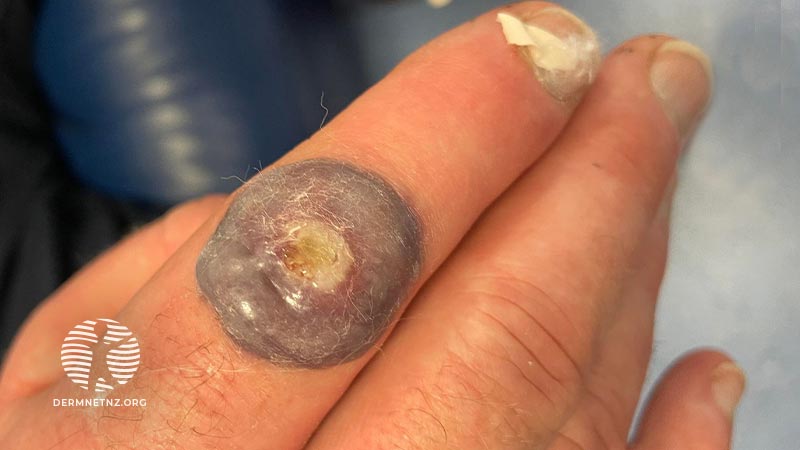Main menu
Common skin conditions

NEWS
Join DermNet PRO
Read more
Quick links
Farmer with enlarging finger lesion
Last reviewed: September 2023
Author: Dr Vidette Wong, Specialty Doctor in Dermatology, Northern Ireland (2023)
Reviewing dermatologist: Dr Ian Coulson.
Edited by the DermNet content department

Background
A 60-year-old farmer attends the assessment unit with a new enlarging lesion on his finger over the past week. From a small red lump, it has grown to a larger tender target-like purple nodule several centimetres in size that appears to have pus just beneath the skin.
The patient admits he did try to ‘burst’ the lesion but very little came out of it. He has become quite concerned because he has also noticed a new painful lump in his underarm.
What is the clinical diagnosis?
This is an orf of the finger and a result of a zoonotic infection that often occurs in a person who have been handling sheep (such as lambing season in this farmer) or goats.
Orf lesions are generally solitary or few in number, and can be tender. They occur most commonly on the fingers, hands or forearms but can appear on the face.
Patients are largely asymptomatic although some may have some systemic upset or associated lymphadenopathy. In immunosuppressed individuals, they can develop into larger, persistent, or fungating lesions.
What organism is responsible for this condition?
Orf is caused by the parapoxvirus, Orfviridae.
This infection is usually diagnosed clinically but can be confirmed on a viral swab, skin biopsy, or vesicular fluid by polymerase chain reaction (PCR). It can also be identified by electron microscopy.
How is this managed? What complications may develop?
Orf is a self-limiting condition that usually resolves in 6 to 12 weeks.
Secondary bacterial infection and regional adenitis may require antibiotics. Orf can also be associated with immunologic reactions such as erythema multiforme, other non-specific toxic erythemas, and pemphigoid.
The lesion should be covered to prevent transmission. It is highly transmissible between animals but human-to-human transmission is rare. It is advisable to use gloves or wash hands with antiseptics thoroughly when handling infected animals.
People can develop recurrent orf infections, but some immunity to the virus is acquired after the first infection so that it is less severe on subsequent occasions.
